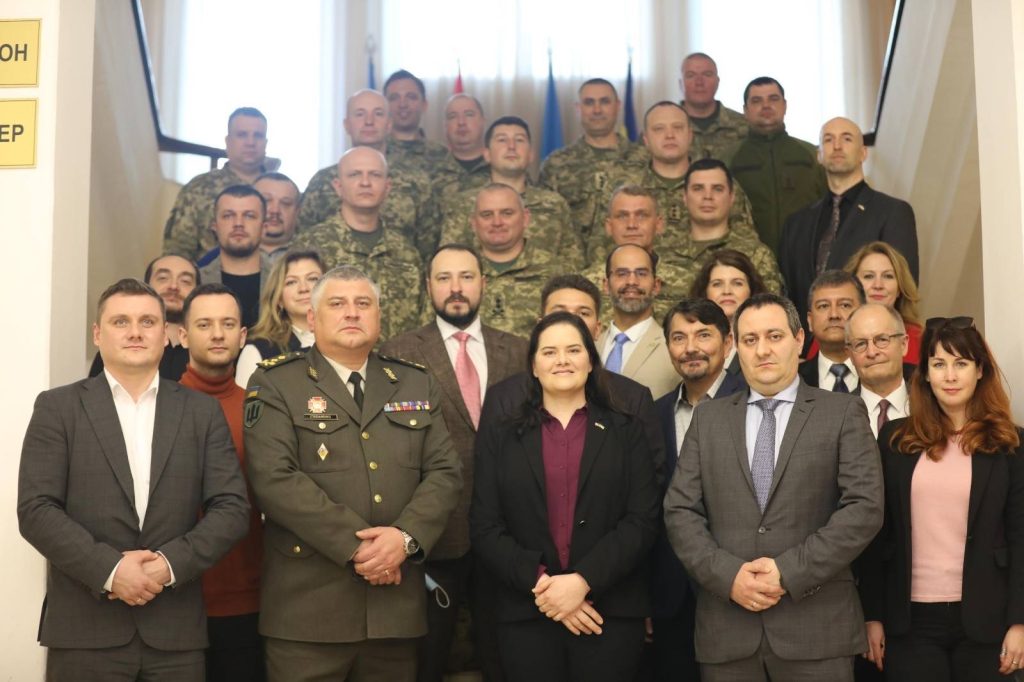
PRESCRIPTION FOR SUCCESS: Ukrainian army Col. Ivan Mykhaylovych Haida, director of the Military Medical Clinical Center of Western Region, discusses his hospital’s capabilities and needs with officers from the U.S. Army during their visit to the military hospital in Lviv in 2017. (Photo by Sgt. Anthony Jones, 45th Infantry Brigade Combat Team)
Modernizing information systems with old-fashioned relationship building.
by Dan Lawton
Ukraine is a key strategic partner for the U.S., so providing assistance to help secure the region’s borders, build partner capacity and improve interoperability with NATO have been crucial initiatives. As part of those efforts, the U.S. Army has led the charge behind implementing information technology (IT) and defensive cybersecurity upgrades that have been critical in the modernization of the region.
Within the Defensive Cyber Operations portfolio of the U.S. Army’s Program Executive Office for Enterprise Information Systems (PEO EIS), the Allied Information Technology (AIT) product office has been the driving force behind modernizing two information systems for the Ukraine Ministry of Defence (U-MOD): the Medical Information System (MIS) and the Logistics Information System (LIS).
The Allied Information Technology product office’s mission is to provide customized command, control, communications, computers, cyber and intelligence solutions in support of partner nations’ objectives to build capacity, interoperability and increase readiness in uncertain, complex and potentially hostile security environments. AIT’s work is tailored to host nation requirements and coalition standards, enabling foreign partners to better secure and defend their sovereignty and security—all of which strengthens the most vital component of any relationship: trust.
BUILDING THE INFRASTRUCTURE
Under DOD’s Ukraine Security Assistance Initiatives umbrella, AIT executed an expansive cybersecurity analysis of Ukraine’s armed forces networks, along with its command-and-control ability. AIT’s experts shared their findings with the Ukraine government and, as a show of unity, Ukraine took AIT’s advice and greenlighted the network modernization efforts.
As part of the modernization, AIT provided ongoing support after the network implementation, all while assisting in establishing and initializing security policies along the way.
None of that was easy to accomplish. For AIT, that process was years in the making. It began with prior IT efforts in the region that helped form a foundation built on trust, mutual respect and AIT’s understanding of Ukraine’s government, culture and ways of thinking—which required an extensive time commitment and a focused, dedicated effort.
“If you don’t understand [Ukraine’s] way of thinking, you’re going to provide something that either they can’t or aren’t interested in using,” said David Waisanen, AIT’s product lead. He also noted that if AIT did not understand Ukraine’s IT infrastructure needs, that could lead to redundancy and negatively impact the partnership—which, ultimately, would harm the relationship between Ukraine and the U.S.
The importance of earning trust through relationship building was not overlooked by Chad Wilhelmi, AIT’s Indo-Pacific Command project manager, who spent four and a half years in Ukraine supporting the region, prior to the most recent hostilities. The personal relationships AIT personnel formed with U-MOD and other government officials, along with sharing office space with the General Staff of the Armed Forces of Ukraine, made gaining Ukraine’s trust possible.
Even with those personal relationships, there were still hurdles that stood in AIT’s way. The roadblocks to overcome were significant. The keys to success, Wilhelmi explained, were maintaining a consistent presence in the region, developing relationships built on trust and being persistent as a team.
“It hasn’t been easy,” Wilhelmi acknowledged. Finding and collaborating with trusted Ukrainian partners and United States European Command counterparts to fight the fight and help implement changes was critical. “That’s what we did, and I think that was the difference.”
MEDICAL INFORMATION SYSTEM
By spring, the information system was tested and accepted and began operating in test mode. For the first time, MIS enabled the forces to keep an electronic database of medical records.
Before the implementation of MIS, all records were kept on paper and were susceptible to human error. With MIS, record-keeping and appointment setting were digitized to improve efficiency while providing a layer of security when it came to protecting soldiers’ sensitive personal medical records—no small feat in the modern-day digital world. The new electronic record system needed a secure location to be stored, too, which was where the AIT cybersecurity operations centers and command-and-control centers factored in.
While enhanced individual soldier record-keeping was important, MIS was about more than that; it was also about tracking the life cycle—from point of injury to hospital discharge to the statistics about all that happened afterward, including tracing follow-up care. MIS served as a document management system that could track this entire cycle, leading to better soldier care across the region—and, ultimately, a stronger and more capable force not just throughout Ukraine, but across allied nations.
LOGISTICS INFORMATION SYSTEM
Prior to LIS, the logistics process was manual and time-consuming. As Wilhelmi described it, armed forces personnel would go to a warehouse, and everything would be tracked on paper. Personnel would have to carry the item from the warehouse to the commander to be stamped—or sometimes drive 40 minutes to the commander’s base for approval—wasting valuable time and energy. The new digital system eliminated all that and dramatically increased productivity and efficiency by cutting out unnecessary, archaic processes.
The benefits of LIS were felt in short order. Just like with MIS, the benefits of LIS have increased Ukraine’s level of readiness and led to a better equipped and prepared force.
WHAT’S NEXT?
MIS was integrated with medical imaging and lab devices, and by late summer, two Ukrainian hospitals began adopting the information system. AIT also developed a mobile platform to allow the system to be accessed on the battlefield.
In January 2023, U-MOD took over ownership of LIS and the network, and is now helping the Armed Forces of Ukraine manage the warehouse. AIT continues to advise U-MOD in test operational mode system capabilities and how it can be used in the future—including achieving fully operational capability—in Ukraine and, potentially, across other allied European nations.

TRACKING PATIENTS
The Medical Information System developed by AIT allows Ukrainian hospitals to track a patient from the point of injury to hospital discharge to the statistics about all that happened afterward, including tracing follow-up care. Col. Anne Naclerio, center, deputy surgeon, U.S. Army Europe, and Col. Sara Breckenridge-Sproat, regional nurse executive, Regional Health Command Europe, speak with a Ukrainian Ministry of Defence doctor about rehabilitative services during a visit to a Ukrainian army hospital in Lviv, Ukraine, in 2017. (Photo by Sgt. Anthony Jones, 45th Infantry Brigade Combat Team)
CONCLUSION
For the Allied Information Technology product office, the IT success stories in Ukraine have been built on a foundation of trust. Before trust can be earned, patience is required—patience in the process, the bureaucracy and the learning curve.
The process of upgrading antiquated IT infrastructure is often not isolated to a specific location. These systems typically include expansion across a region, which requires extensive planning before the implementation can even begin. Taking a long view and factoring in how quickly technology changes and should be upgraded for maximum security, on top of the existing capability efforts, is just as critical. Not thinking that way is doing a disservice to the partner and can hamper even the most longstanding relationships. Everything from implementing a virtual training environment, to providing guidance on basic network security practices like password protection, to educating on administrator tools need to be considered as building blocks to any long-term IT infrastructure plan. AIT has taken this long view approach in Ukraine to set the region up for success.
“I think this has been critical to AIT’s success in Ukraine and why they still look to us for IT,” Wilhelmi said. “We didn’t just deliver. We didn’t go there and say, ‘OK, you can do what you want with this hardware. Here you go. Good luck. Call us if you need something.’ ”
When it comes to where AIT can lead Ukraine in the future—and other countries across Europe—in terms of cybersecurity, IT support and building partner capacity, AIT is well-equipped and prepared for the challenge.

ALL TOGETHER NOW
Ukraine Ministry of Defence leaders, the Armed Forces of Ukraine General Staff, and members of the Ukraine Logistics Forces Command, the Ukraine Special Operations Forces Command, AIT and system integrators gather at a case kickoff meeting in Kyiv in 2020. (Photo courtesy of AIT)
“Ukraine and all of Europe are so focused on cybersecurity now,” Waisanen said. “We’re doing a lot of cybersecurity cases and we’re becoming experts at it. We’re trying to become more of a center of excellence for cybersecurity for the U.S. Army.” He added that AIT is uniquely positioned to do that because of its strong ties and relationships built with the Ukrainian government.
The AIT team was there for Ukraine from start to finish and beyond. They installed the IT infrastructure, helped to develop security policies for the new infrastructure and assisted in implementing those policies, and have continued to provide guidance and support afterward. Through persistence, presence and relationship building, allies have become more than friendly. They have become trusted partners.
For more information about PEO EIS’ AIT project office and its mission, go to https://www.eis.army.mil/programs/ait.
DAN LAWTON provides strategic communication contract support to PEO EIS at Fort Belvoir, Virginia, as a writer and editor for Bixal. He holds a B.A. in communications from New England College.







